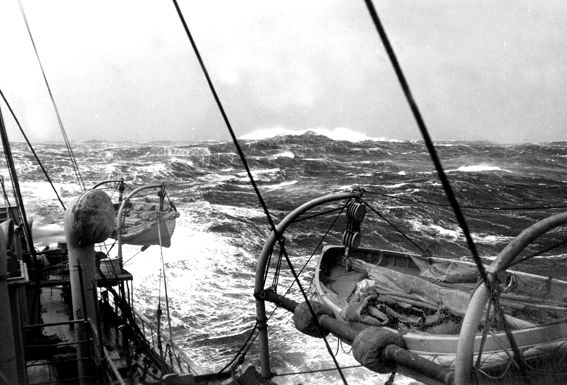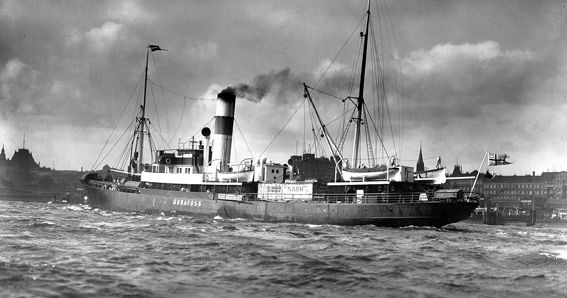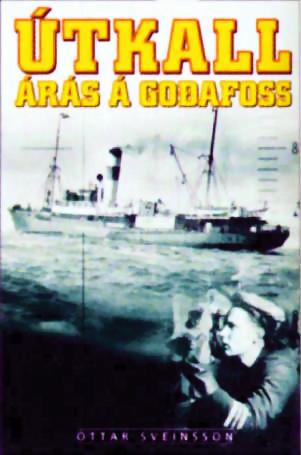Rescue – Goðafoss under Attack
An Icelandic-German tragedy
How Iceland's flagship, the Goðafoss, was torpedoed by a German U-boat in WWII. The book provides a look into Icelandic way of life during WWII, it also contains secred documents and accounts from the U-boat crew.
On 10 November 1944, the Goðafoss was headed home to Iceland as part of an Allied convoy, after a two-month trip to New York. The Goðafoss was the largest cargo/passenger vessel in the Icelandic fleet – the pride of the nation. Aboard were 43 Icelanders, along with 20 Britons who had been rescued just half an hour before from a blazing oil tanker.
 News that the Goðafoss was on her way home had spread through the little town of Reykjavík. Friends and relatives of passengers and crew were filled with anticipation. But, unbeknownst to them, just ahead of the convoy at the mouth of Faxaflói bay, a German U-boat lay in ambush.
News that the Goðafoss was on her way home had spread through the little town of Reykjavík. Friends and relatives of passengers and crew were filled with anticipation. But, unbeknownst to them, just ahead of the convoy at the mouth of Faxaflói bay, a German U-boat lay in ambush.
Two hours out from Reykjavík, and in sight of land, a torpedo smashed into the port side of the Goðafoss, tearing a huge rift in the hull. Within about seven minutes the ship foundered. Adults and children fought for their lives in the cold Atlantic. As news of the ship's fate reached Reykjavík, people gathered on the dockside, racked by fear and uncertainty. Nineteen Icelandic lives were saved, but only two of the Britons, who had already been rescued once that day, survived. For Iceland, a non-combatant nation, it was the greatest tragedy of World War II.
The story is told by Óttar Sveinsson, who has specialised in accounts of real-life events. He has published 16 books, all telling true stories of adventure and heroism on land and sea and in the air. Every year since 1994, Óttar's books have been among Iceland's bestsellers. They have been published in English, Dutch and Danish, among other languages. In 1995 the Hollywood film company Rescue 911 re-enacted events recounted by Óttar, when snowmobilers were rescued from a deep crevasse in the ice of the Snæfellsjökull glacier. Óttar has also collaborated with the BBC, Reader's Digest, etc.
 In one book Óttar tells the extraordinary story of the Westman Islands eruption of 1973, when all the 5,000 islanders, along with many of their possessions, were evacuated to the mainland in a single night. Another book is an account of the rescue of the crew of a DC-4 passenger plane, Geysir, from the top of the Vatnajökull glacier. The aircraft had been missing without trace for nearly a week when an SOS call was unexpectedly picked up: “All alive. Location unknown.”
In one book Óttar tells the extraordinary story of the Westman Islands eruption of 1973, when all the 5,000 islanders, along with many of their possessions, were evacuated to the mainland in a single night. Another book is an account of the rescue of the crew of a DC-4 passenger plane, Geysir, from the top of the Vatnajökull glacier. The aircraft had been missing without trace for nearly a week when an SOS call was unexpectedly picked up: “All alive. Location unknown.”
Óttar Sveinsson was born in Reykjavík on 14 October 1958. After studying and working in Sweden and Denmark in the 1970s, he started work as a journalist on daily DV in 1988. In 1994 his first book was published: an account of various heroic rescues by Iceland Coast Guard helicopter crews. The book was an immediate success. Óttar lives in Hamburg and Reykjavík, and works in writing and publishing. In 2003, when he stopped working as a journalist, he founded his own publishing company, Útkall (Rescue) with his cousin.
At Christmas 2009 a new film will be shown, based on the events which are recounted in Útkall - árás á Goðafoss (Rescue – Goðafoss under Attack), which was first published in 2003. Until then, the story told by Óttar in his book was a largely unknown chapter of the history of World War II in Iceland. For the Icelanders of the time, the loss of the Goðafoss with so many lives was a disaster comparable to the sinking of the Titanic.
 Útkall - árás á Goðafoss provides insight into the Icelandic way of life during World War II, and depicts many individuals connected with the torpedo attack. Óttar describes the ship's last journey, including interviews with surviving crew and passengers, and relatives. The book contains previously-unpublished material on the journey of the U-300 submarine to Iceland. Also included is interesting information on a visit to Iceland by Marlene Dietrich, at the same time as the Goðafoss left harbour for the last time. The Hollywood star met, for instance, Sveinn Björnsson, who had been appointed president that summer, when the modern Icelandic Republic was founded. The new president had been to Washington and met with US President Roosevelt. On that visit he received a splendid Packard automobile, which was sent to New York and loaded onto the Goðafoss. The ship was just outside the entrance to Faxaflói bay and the safety of Reykjavík harbour when the U-boat attacked. Óttar's book also contains information from the U-boat captain's log, secret documents, letters, and accounts by the U-boat crew, as well as reports of interrogation by British and American military personnel, after the crew of the U-300 made a miraculous escape when their submarine was sunk by the Allies. Also in the book are photographs never before published in Iceland.
Útkall - árás á Goðafoss provides insight into the Icelandic way of life during World War II, and depicts many individuals connected with the torpedo attack. Óttar describes the ship's last journey, including interviews with surviving crew and passengers, and relatives. The book contains previously-unpublished material on the journey of the U-300 submarine to Iceland. Also included is interesting information on a visit to Iceland by Marlene Dietrich, at the same time as the Goðafoss left harbour for the last time. The Hollywood star met, for instance, Sveinn Björnsson, who had been appointed president that summer, when the modern Icelandic Republic was founded. The new president had been to Washington and met with US President Roosevelt. On that visit he received a splendid Packard automobile, which was sent to New York and loaded onto the Goðafoss. The ship was just outside the entrance to Faxaflói bay and the safety of Reykjavík harbour when the U-boat attacked. Óttar's book also contains information from the U-boat captain's log, secret documents, letters, and accounts by the U-boat crew, as well as reports of interrogation by British and American military personnel, after the crew of the U-300 made a miraculous escape when their submarine was sunk by the Allies. Also in the book are photographs never before published in Iceland.
Útkall - árás á Goðafoss, which tells of the fate of the crews of the Goðafoss and the German U-boat, was a bestseller in Iceland. This dramatic event in the history of Germany and Iceland relates to the life and death of people of both nations, and contains important source material for modern history. On both sides of the Atlantic, in Hamburg, Reykjavik and elsewhere, members of the crews of the Goðafoss and the U-300 are still alive today.